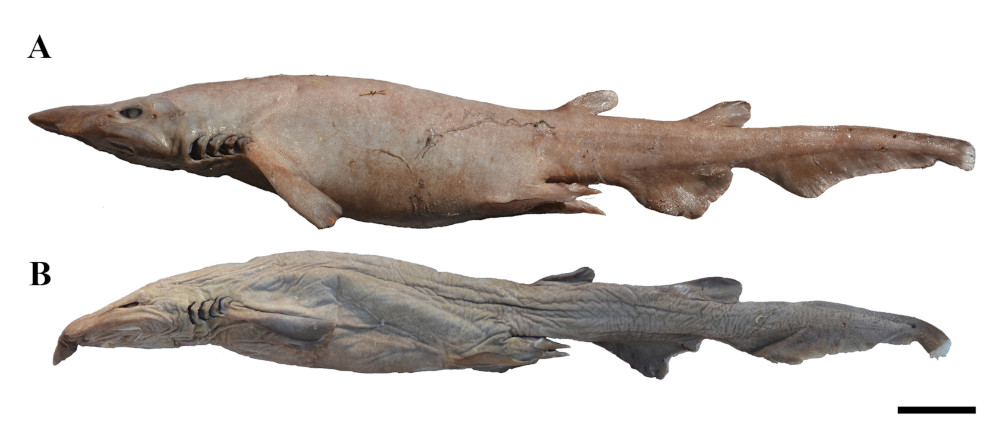Apristurus manocheriani
Cordova & Ebert, 2021
Classification: Elasmobranchii Carcharhiniformes Pentanchidae
Reference of the original description
Apristurus manocheriani (Carcharhiniformes: Pentanchidae), a new species of catshark from the Southwest Indian Ocean. Journal of the Ocean Science Foundation, 38, 13–26
Apristurus manocheriani (Carcharhiniformes: Pentanchidae), a new species of catshark from the Southwest Indian Ocean. Journal of the Ocean Science Foundation, 38, 13–26
Types
Apristurus manocheriani
Holotype: CAS: ICH 247255; Paratype: CAS: ICH 247256; CAS: ICH 247257; CAS: ICH 247258; CAS: ICH 247259; CAS: ICH 247260; CAS: ICH 247261; CAS: ICH 247262;
Apristurus manocheriani
Holotype: CAS: ICH 247255; Paratype: CAS: ICH 247256; CAS: ICH 247257; CAS: ICH 247258; CAS: ICH 247259; CAS: ICH 247260; CAS: ICH 247261; CAS: ICH 247262;
Description :
Citation: Apristurus manocheriani Cordova & Ebert, 2021: In: Database of modern sharks, rays and chimaeras, www.shark-references.com, World Wide Web electronic publication, Version 01/2026
Please send your images of "Apristurus manocheriani" to info@shark-references.com

Apristurus manocheriani Cordova & Ebert, 2021, holotype, lateral view, adult male, 558 mm TL (CAS-ICH 247255) before preservation (A) and after preservation (B); scale bar = 5 cm © Cordova, J.A. & Ebert, D.A.

Apristurus manocheriani Cordova & Ebert, 2021, holotype, lateral view, adult male, 558 mm TL (CAS-ICH 247255) before preservation (A) and after preservation (B); scale bar = 5 cm © Cordova, J.A. & Ebert, D.A.
Common names
 Manocherian’s Catshark
Manocherian’s Catshark
 Manocherian’s Catshark
Manocherian’s Catshark
Short Description
Original diagnosis of CORDOVA & EBERT, 2021 [29831]: A new species in spongiceps subgroup of Apristurus, as defined by Nakaya & Sato (1999), distinguished from all congeners by a combination of characteristics: an overall uniformly whitish “porcelain” colored body with lighter colored anal and caudal-fin margins and a distinct white spot on tail tip vs. a uniform dark brown to grayish, or blackish, body coloration, variably with blotches, flecks, spots, or squiggles, in all other spongiceps subgroup species (except A. albisoma and A. aphyodes with similar light coloration, but subtle differences); clasper hooks present vs. absent; oral papillae absent or sparsely covering oral cavity roof vs. distinct and densely covering oral cavity roof; dorsal caudal margin with widely spaced, non-overlapping dermal denticles vs. closely spaced, overlapping denticles; lower tooth counts, i.e. 46–57 in upper jaw and 44–50 in lower jaw vs. 56–71 and 49–70 respectively.
Original diagnosis of CORDOVA & EBERT, 2021 [29831]: A new species in spongiceps subgroup of Apristurus, as defined by Nakaya & Sato (1999), distinguished from all congeners by a combination of characteristics: an overall uniformly whitish “porcelain” colored body with lighter colored anal and caudal-fin margins and a distinct white spot on tail tip vs. a uniform dark brown to grayish, or blackish, body coloration, variably with blotches, flecks, spots, or squiggles, in all other spongiceps subgroup species (except A. albisoma and A. aphyodes with similar light coloration, but subtle differences); clasper hooks present vs. absent; oral papillae absent or sparsely covering oral cavity roof vs. distinct and densely covering oral cavity roof; dorsal caudal margin with widely spaced, non-overlapping dermal denticles vs. closely spaced, overlapping denticles; lower tooth counts, i.e. 46–57 in upper jaw and 44–50 in lower jaw vs. 56–71 and 49–70 respectively.
Dentition
Teeth numerous and large; similar in upper and lower jaw; upper anteriors with long, robust, central cusp, flanked by one or two acutely pointed lateral cusps on each side, less than one-half height of central cusp; upper laterals with long central cusp flanked by two successively smaller cusps on each side, about one-half or less than height of preceding cusp; lower teeth similar to uppers, with central cusp of anteriors having one or two lateral cusps on each side, and laterals flanked by two lateral cusps on each side. Sexual dimorphism apparent: adult male jaws more pronounced than adult females, very strongly arched, adult female jaws more weakly arched. Tooth counts in first row of upper jaw 51 (46–57) and in first row of lower jaw 49 (44–50). [29831]
Teeth numerous and large; similar in upper and lower jaw; upper anteriors with long, robust, central cusp, flanked by one or two acutely pointed lateral cusps on each side, less than one-half height of central cusp; upper laterals with long central cusp flanked by two successively smaller cusps on each side, about one-half or less than height of preceding cusp; lower teeth similar to uppers, with central cusp of anteriors having one or two lateral cusps on each side, and laterals flanked by two lateral cusps on each side. Sexual dimorphism apparent: adult male jaws more pronounced than adult females, very strongly arched, adult female jaws more weakly arched. Tooth counts in first row of upper jaw 51 (46–57) and in first row of lower jaw 49 (44–50). [29831]
Remarks
shark-references Species-ID=16146;
shark-references Species-ID=16146;

















